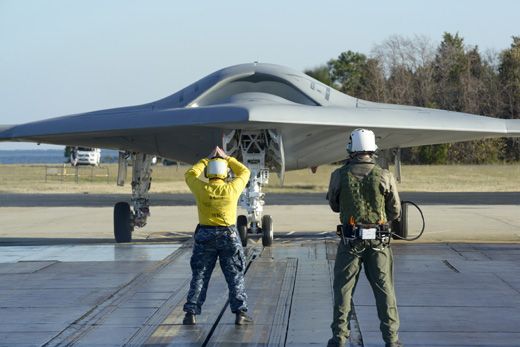The X-47 Ships Out
The Navy’s unmanned combat aircraft makes a historic takeoff, and prepares for carrier trials at sea.
/https://tf-cmsv2-smithsonianmag-media.s3.amazonaws.com/filer/UCAS-D.jpg)
The U.S. Navy’s dream of a pilotless combat jet that can fly off an aircraft carrier, refuel in the air, complete its mission and then land safely back on the flat top has taken a couple of steps closer to reality.
On November 29 one of the Navy’s two bat-shaped, tail-less X-47B demonstration aircraft catapulted into the air and the history books at Naval Air Station Patuxent River, Maryland. Also known as the Unmanned Combat Air System demonstrator (UCAS-D), the craft was the first unmanned aerial vehicle (UAV) to be launched by the same kind of steam-powered catapult currently used on Navy carriers. Vice Admiral David Dunaway, head of Naval Air Systems Command, said the launch and 10-minute flight “will leave a mark in history.”
Three days earlier, the other X-47B demonstrator traveled down the Chesapeake Bay by barge to Norfolk, Virginia, where a large crane hoisted it aboard the nuclear-powered aircraft carrier USS Harry S. Truman (CVN-75)—another first—for sea trials starting this month.
Captain Jaime Engdahl, the Navy’s UCAS program manager, told reporters the day after the catapult test that the sea trials will evaluate how the X-47B operates in the confined space of a carrier. An operator will drive the vehicle around the deck using a wrist-mounted wireless control unit, rather than the joystick typically used to control other large UAVs. Standing in front of the vehicle, the operator in effect mimics the hand gestures of the yellow-shirted flight deck officer who directs aircraft taxiing around the deck. The wrist-mounted unit controls the X-47B’s wheelbrakes, engine thrust and nosewheel steering. (See video here.)
During the Truman sea trials, the vehicle will be maneuvered—slowly—around the flight deck, aircraft elevators and hangar deck. The operator also will move it into place at the launching catapult, and disengage it from the arresting wires that trap aircraft during a carrier landing. The idea is to be sure the X-47B can get into or out of position as quickly as manned jets.
The fighter jet-sized drone won’t be doing any take-offs and landings, though, at least not yet. Engdahl said test flights are slated to begin next summer. The Navy also plans to demonstrate aerial refueling in 2014 using both the Navy’s probe and drogue technology and the boom/receptacle method used by the U.S. Air Force.
The 44,500-pound X-47B, which is more than 38 feet long with a wingspan over 62 feet, has been in development by the Navy and lead contractor Northrop Grumman since 2007. These first two vehicles are just demonstration versions—the Navy is expected to seek proposals for an operational version by early next year. With China developing long range “ship killer” missiles and stealthy jet fighters, and with the Pentagon’s strategic policy shift to the Asia-Pacific region, Navy leaders want to ensure that aircraft carriers will be able to project power and penetrate an enemy’s airspace on the other side of the globe. A fighter without a human pilot could be part of the solution.
